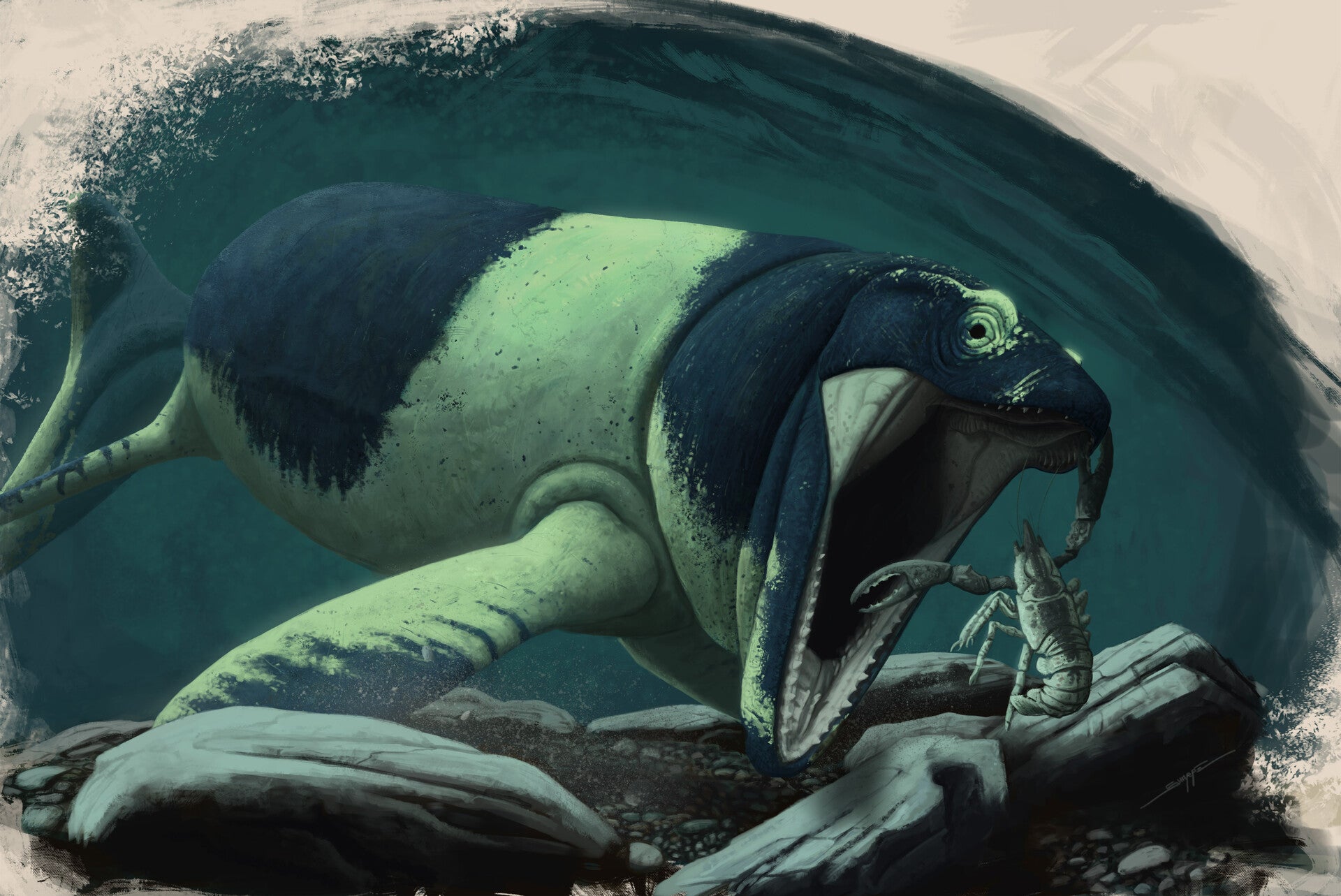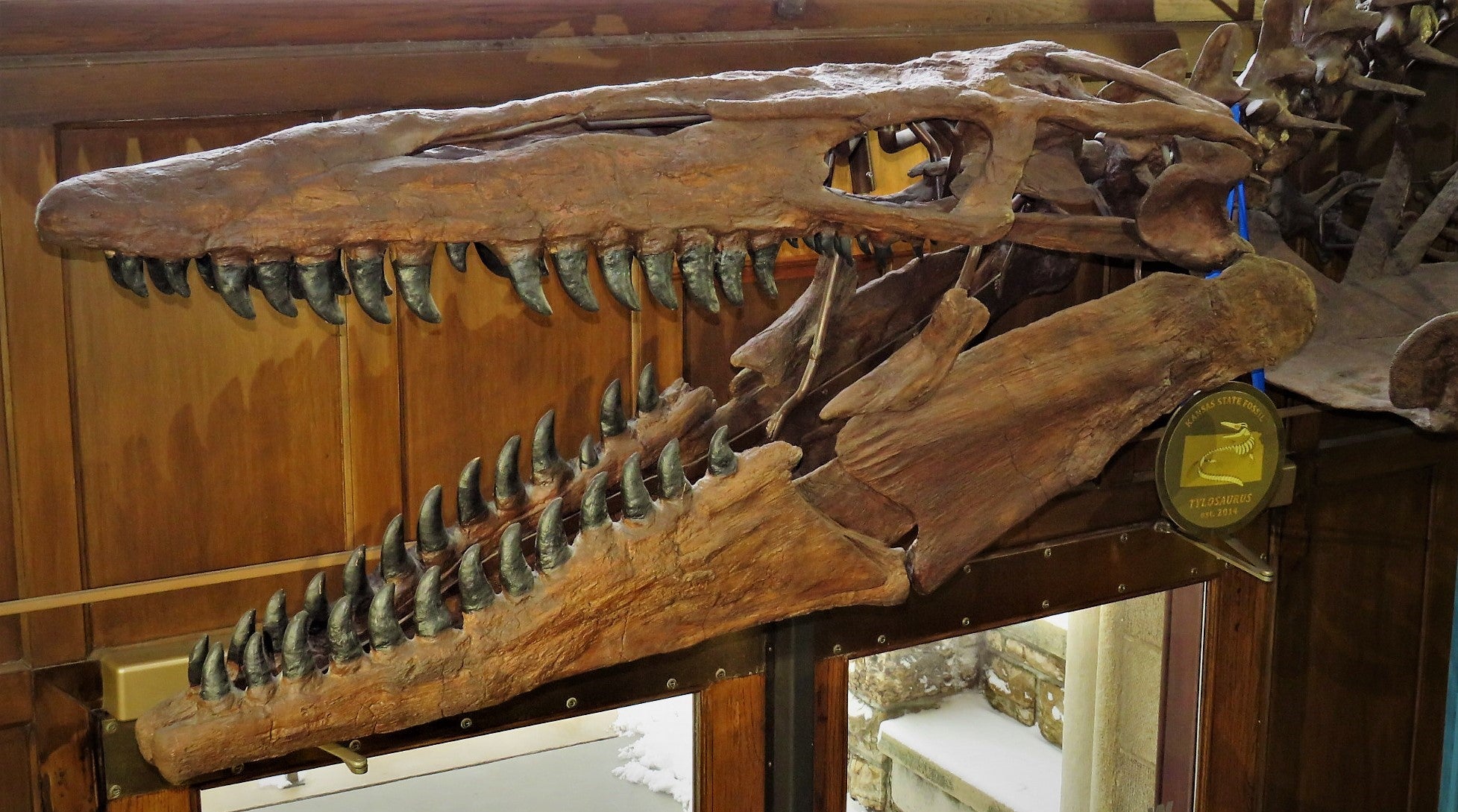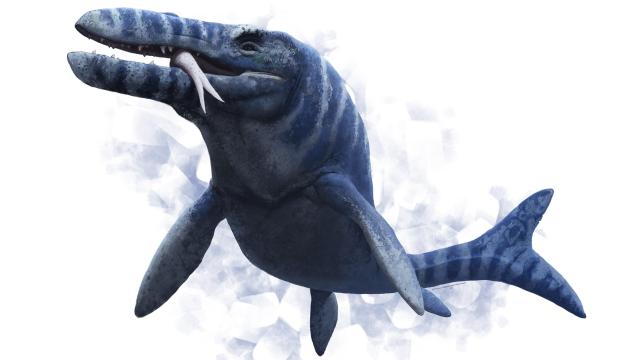You wouldn’t want to swim in Late Cretaceous seas. If you’ve seen the first Jurassic World movie, you’ll recognise a mosasaur as the creature that leapt from the water to eat a great white shark. That film may have exaggerated the real size of mosasaurs, but the effect is genuine: some species could reach terrifying lengths. These reptiles spent their lives in the water, but they breathed air. They had fins, long tails, mouths full of teeth, and could be anywhere from 10 to 50 feet in length. Scientists classify them as ‘squamates,’ a term that refers to lizards and snakes. And yet, pinpointing what mosasaurs truly were remains elusive.
Two presentations at the annual meeting of the Society of Vertebrate Paleontology in Toronto this November offered a look into current mosasaur research: how they may have captured and devoured prey, whether they were venomous, as well as where they may have roamed and what they might have eaten. These revelations are the latest windows into marine reptiles that lived some 66 million to 100.5 million years ago.
Henry Sharpe, an undergraduate student at the University of Alberta, and Amelia R. Zietlow, a PhD candidate at the Richard Gilder Graduate School at the American Museum of Natural History in New York, described some of their ongoing research into mosasaur jaws. These fossils offer exciting clues as to how they may have captured prey.
When many of us think of toothed aquatic predators, we might assume death by swift, powerful bite. But that wasn’t necessarily the case with mosasaurs. Not only do mosasaurs possess a kinetic, or moveable, jaw, but scientists like Sharpe and Zietlow are unravelling what other fearsome capabilities they may have had in common with their living squamate relatives.
Jaws that could open extra wide
To begin with, squamates have an intramandibular joint — a joint in the middle of the lower jaw. Some lizards and snakes “have developed a hinge in the middle of these bones,” Sharpe explained. “And this hinge is sometimes looser and sometimes more rigid, depending on the species, but they all have basically a joint in the middle of the lower jaw.” That joint allows motion between the two halves. “The jaw can kind of bend forward at that point in some taxa,” Zietlow said. “In other taxa, it can kind of bend outward. That varies from mosasaur to mosasaur.”

Sharpe, Zietlow, and their colleagues studied rare complete mosasaur lower jaws in North American museums, “because we wanted to look at how mosasaur jaws related to other marine animals versus other squamates,” said Sharpe. In other words, they are on a quest to better understand how mosasaurs ate based on these fossils, as well as how other species — including living whales, snakes and lizards, and extinct marine reptiles — might compare to mosasaurs.
For example, take the jaws of today’s snakes and hyenas. Snake jaws aren’t fused together, and they’re delicate. This means they can not only move each separate jaw bone but both sets of teeth independently as they grab and swallow their prey. “They actually walk the jaws up the prey as they eat it,” described Zietlow. This is vastly different to a hyena jaw, a solidly built structure with no flexibility that is strong enough to crush bones.
Now consider what is known about most mosasaur species: They generally didn’t have serrated teeth to rip off chunks of flesh, and they didn’t have arms to hold prey, but they had flexible mandibles. This, Zietlow asserts, indicates they probably ate what they could swallow whole. Yet, “most mosasaurs don’t seem to have had strong bites proportionally for how big they are,” she said. “That’s where this research question initially came from: OK, so what are they doing? How are they hunting prey? How are they killing it? How are they eating it?”

Zietlow explained that, while scientists aren’t sure exactly how mosasaurs ate, their anatomy does suggest certain feeding strategies. Prognathodon, an enormous mosasaur species, were the “meanest-looking animals that ever lived,” she said, with “huge conical teeth with serrations on both sides and built-in bony ridges above their eyes. They’re the ones that we most often find with plesiosaurs and mosasaurs and other large vertebrates inside of them.” Those serrated teeth are an anomaly, as very few mosasaurs had them, and this leads paleontologists to believe that those with serrated teeth had the ability to rip chunks of flesh from their prey. There is, Zietlow added, as-yet unpublished gut content evidence that Prognathodon may have been ripping substantial body parts off of prey.
The middle joint is not the only moveable aspect of the mosasaur jaw. There’s also the mandibular symphysis, the point at which two lower jaw bones connect. In our skulls, the mandibular symphysis is fused right at our chin. Our lower jaw is, essentially, one solid bone. In mosasaurs, Sharpe explained, this joint was not fused; it was looser. Like Zietlow, Sharpe noted that gut contents in some mosasaur fossils shows that “we have mosasaurs that are eating plesiosaurs and turtles and other mosasaurs that are up to half their length. So they’re eating very large things. And having these jaws that could open up like this basically to swallow prey would be very, very helpful.”
Remarkably, mosasaurs could have used their tongue to smell. Like other squamates, such as snakes and monitor lizards, mosasaurs had two telltale holes in the bottom of their jaw that indicate they had that specific organ.
“We know that they had it,” Zietlow confirmed. “To what degree they were using it, we’re not so sure, because they’re aquatic. It’s possible they were using other senses — for example, their ears appear to be very well developed. This is still an active area of research. “
A venomous bite?
If mosasaurs had moveable jaws, if their jaws were proportionately weak, and if they used their tongues to smell, might they also have featured another familiar trick of modern squamates? Could mosasaurs have been venomous?
It’s not a new idea, but the capacity for venom in extinct creatures is tough to prove. Until recent decades, many living venomous lizards and snakes weren’t even recognised as such by scientists, typically because the species were too small to affect humans or the venom in question wasn’t directly fatal. Rather, it was an anticoagulant. “It’s helping their prey bleed out,” he said. For humans, the amount of bleeding was minimal, so it was easy to miss. “Because of this,” Sharpe concluded, “scientists realised that grooves in the teeth are not a 100% accurate indicator for venom.”

Iguanas, which don’t have grooves in their teeth, are one of the squamates now known to have been venomous. In iguanas, Zietlow stated, “the venom sac is actually vestigial, so they’re not using it, they’re not secreting it. It’s just like a saliva gland that’s modified. It’s a venom gland, but they don’t use it anymore because they’re primarily herbivorous.”
And this, she explained further, has implications for the venomous lizard family tree called toxicoferans, and it includes snakes, monitor lizards, gila monsters, and now iguanas. “They all,” she said, “share a common ancestor, and what that means is that the ancestor to this group probably was venomous.” That’s significant, she explained, because “even if mosasaurs weren’t using venom to kill things, it’s possible that, like iguanas, it was present but vestigial.”
Diets of turtles, mollusks, crustaceans, fish, and more
But what were mosasaurs eating, and, with multiple sizes and species of mosasaurs in the same ocean, how were they able to coexist?
This is the focus of ongoing research by Femke Holwerda, a postdoctoral research fellow at the Royal Tyrrell Museum of Palaeontology, who presented what she categorised as a “pilot study” at the SVP annual meeting. She has done an enormous amount of work studying fossils of creatures that lived within the Bearpaw Sea in southern Alberta, Canada, all of which are housed at the Royal Tyrrell Museum. The Bearpaw Sea was part of the larger Western Interior Seaway, a Cretaceous body of water that cut through what is now North America.
That sea was home to at least four or five species of mosasaur (Mosasaurus missourensis, Prognathodon overtoni, Plioplatecarpus primaevus, Tylosaurus sp., and a possible Mosasaurus conodon) as well as turtles, sharks, sawfish, lobsters, cuttlefish, elasmosaurs, fish such as Enchodus, mollusks, and ammonites. Holwerda wants to reveal more about these ancient interrelationships, which is tricky business. Reconstructing ecosystems that are 66 million to 145 million years old is no small feat. Absent direct evidence like gut contents, her research involves considerable detective work.
“Mosasaurs are the star of the show, but I thought it was important to look at the other components of the ecosystem,” Holwerda said.
Which is, in part, which makes her research so intriguing. Mosasaurs may no longer exist, but almost everything else she studies has modern descendants. All of the aforementioned species have been found within the Bearpaw Formation, with the exception of sharks and sawfish, two species found in other locations but known to co-exist at the same time period.
Her research is multi-faceted and still a work in progress To get a better picture of ancient diet, she’s analysed mosasaur dental microwear, studying the pits, scratches, and gouges on fossil teeth. 2D microwear means observing and counting the number of pits versus scratches on each tooth. 3D microwear, which involves the use of specialised software, offers substantially more info and less human error. Both provide a look into what a species was eating over the past several weeks or months prior to death.
“Some say 2D microwear is no longer relevant now that there is the more in-depth 3D microwear analysis,” she admitted, “but I still think it adds information to the story, especially coupled with 3D microwear.”
Her plan is to use both, but for her presentation at this year’s SVP meeting, she discussed the 2D dental microwear results, energy-dispersive x-ray spectroscopy (EDX) and isotopic analysis.
Holwerda has been able to apply that knowledge and correlate it to where these species may have been feeding. In other words, she was able to find evidence for niche partitioning within the Bearpaw Sea. And she did this by studying strontium and barium over calcium within the fossils. Of note, she found that the enormous mosasaur Prognathodon shared a diet with sawfish; both are durophagous, or known to have eaten harder substances. Those harder substances, based on the fossils found in the Bearpaw Sea, would have at least included mollusks, crustaceans, possibly ammonites. The medium-sized mosasaur Plioplatecarpus seems to have eaten the same fish as Cretaceous sharks. And Mosasaurus appears to have been taking advantage of all available food in the Bearpaw Sea, as the results overlapped the diets of all other large ancient marine species she sampled.
Certain isotopes offer insight into how deeply mosasaurs may have been able to dive, which is how Holwerda was able to determine that only Prognathodon and Mosasaurus — two of the largest species — appear to have been swimming in the deepest parts of ancient seas.
Remarkably, Holwerda is even able to determine the salinity and temperature of the water through oxygen isotopes found in tooth fossils. Strontium isotopes offered indications of how close to shore mosasaurs may have migrated or whether they remained out in the ocean. This is because, according to what scientists understand thus far, strontium differences in seawater will only get recorded closer to shore, as these indicate freshwater input. Strontium in salt water is more or less stable.
Her research so far indicates that the various mosasaur species in the Bearpaw Sea lived in different areas and ate different things, but more data is needed. Her biggest concern at the moment is what she refers to as “those pesky, pesky turtles.” Although she sampled about a handful of turtles from the Royal Tyrrell Museum, only one produced enough material for the mass-spectrometer to provide any data.
“Prognathodon should be eating those turtles,” she stated, “or you should see that from the signal, because there are Prognathodon with turtle remains in their stomach.” To determine this with any accuracy, she would like a more robust turtle sample for comparison.
Holwerda expressed concern about modern climate change, wondering, “What can we learn from the past, from that warm Cretaceous sea?” It was a time, she said, when neither the North or South Pole had any ice and sea levels were much higher. “For the mosasaurs, of course, it was perfect! It was nice and warm.” But as our planet heats up, what does that mean for existing marine animals?
There is still much work to be done by all three of these paleontologists, and both groups indicate there are many questions they have yet to answer.
“Mosasaurs are such common fossils,” Zietlow said. “They’ve had a lot of work done on them; they’re related to living animals, and yet we still don’t know the most basic fact about them which is: what are they? We know they’re lizards — but what kind of lizard are they?”
Jeanne Timmons (@mostlymammoths) is a freelance writer based in New Hampshire who blogs about paleontology and archaeology at mostlymammoths.wordpress.com.
